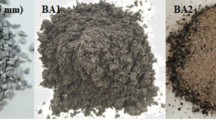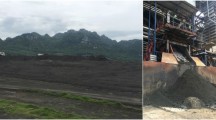Abstract
This paper shows a recycling method of two waste materials, bottom ash (BA) and calcium carbide residue (CR), as a new cementing material in concrete to reduce ordinary Portland cement (OPC) usage. BA and CR were ground separately and mixed in a ratio of 70:30 by weight to use as a cementing material in concrete and was designated as BC. BC concretes were prepared with the same method as that used for conventional concrete. The comparison mechanical properties between those of BC concrete and conventional concrete were evaluated. The results demonstrated that BC concrete obtained 28-day compressive strength of 29.7 MPa and increased to 44.3 MPa by using an OPC addition of 55 kg/\(\hbox {m}^{3}\). The mechanical properties of BC concrete, such as elastic modulus and tensile strength, were the same as those of conventional concrete when both concretes had the same compressive strength. Moreover, the produced concrete from the BC cementing material had the same abrasion resistance as conventional concrete. The results also demonstrate that the BC could be used as an environmentally friendly alternative cementing material for concrete.
Similar content being viewed by others
References
Habert, G.; Billard, C.; Rossi, P.; Chen, C.; Roussel, N.: Cement production technology improvement compared to factor 4 objectives. Cem. Concr. Res. 40(5), 820–826 (2010)
Gartner, E.: Industrially interesting approaches to “low-\(\text{CO}_2\)” cements. Cem. Concr. Res. 34(9), 1489–1498 (2004)
Rerkpiboon, A.; Tangchirapat, W.; Jaturapitakkul, C.: Strength, chloride resistance, and expansion of concretes containing ground bagasse ash. Constr. Build. Mater. 101, 983–989 (2015)
Tangchirapat, W.; Jaturapitakkul, C.: Strength, drying shrinkage, and water permeability of concrete incorporating ground palm oil fuel ash. Cem. Concr. Compos. 32(10), 767–774 (2010)
Kroehong, W.; Damrongwiriyanupap, N.; Sinsiri, T.; Jaturapitakkul, C.: The effect of palm oil fuel ash as a supplementary cementitious material on chloride penetration and microstructure of blended cement paste. Arab. J. Sci. Eng. 41(12), 4799–4808 (2016)
Ma, B.; Wang, Y.; Fu, H.: Effect of rice husk ash on the thaumasite form of sulfate attack of cement-based materials. Arab. J. Sci. Eng. 39(12) (2014)
Jaturapitakkul, C.; Roongreung, B.: Cementing material from calcium carbide residue-rice husk ash. J. Mater. Civ. Eng. 15(5), 470–475 (2003)
Phoo-ngernkham, T.; Sata, V.; Hanjitsuwan, S.; Ridtirud, C.; Hatanaka, S.; Chindaprasirt, P.: Compressive strength, bending and fracture characteristics of high calcium fly ash geopolymer mortar containing portland cement cured at ambient temperature. Arab. J. Sci. Eng. 41(4), 1263–1271 (2016)
Rao, G.M.; Rao, T.G.: Final setting time and compressive strength of fly ash and GGBS-based geopolymer paste and mortar. Arab. J. Sci. Eng. 40(11), 3067–3074 (2015)
Kim, H.; Lee, H.: Use of power plant bottom ash as fine and coarse aggregates in high-strength concrete. Constr. Build. Mater. 25(2), 1115–1122 (2011)
Aggarwal, P.; Aggarwal, Y.; Gupta, S.: Effect of bottom ash as replacement of fine aggregates in concrete. Asian J. Civ. Eng. (Build. Hous.) 8(1), 49–62 (2007)
Andrade, L.B.; Rocha, J.; Cheriaf, M.: Evaluation of concrete incorporating bottom ash as a natural aggregates replacement. Waste Manage. (Oxf.) 27(9), 1190–1199 (2007)
Ramadoss, P.; Sundararajan, T.: Utilization of lignite-based bottom ash as partial replacement of fine aggregate in masonry mortar. Arab. J. Sci. Eng. 39(2), 737–745 (2014)
Jaturapitakkul, C.; Cheerarot, R.: Development of bottom ash as pozzolanic material. J. Mater. Civ. Eng. 15(1), 48–53 (2003)
Cheriaf, M.; Rocha, J.C.; Pera, J.: Pozzolanic properties of pulverized coal combustion bottom ash. Cem. Concr. Res. 29(9), 1387–1391 (1999)
Somna, K.; Jaturapitakkul, C.; Kajitvichyanukul, P.: Microstructure of calcium carbide residue-ground fly ash paste. J. Mater. Civ. Eng. 23(3), 298–304 (2010)
ASTM C618: Standard specification for coal fly ash and raw or calcined natural pozzolan for use in concrete. In: Annual Book of ASTM Standard. ASTM, Philadelphia (2015)
Pangdaeng, S.; Phoo-ngernkham, T.; Sata, V.; Chindaprasirt, P.: Influence of curing conditions on properties of high calcium fly ash geopolymer containing Portland cement as additive. Mater. Des. 53, 269–274 (2014)
Krammart, P.; Tangtermsirikul, S.: Properties of cement made by partially replacing cement raw materials with municipal solid waste ashes and calcium carbide waste. Constr. Build. Mater. 18(8), 579–583 (2004)
Abdulmatin, A.; Tangchirapat, W.; Jaturapitakkul, C.: Effect of type of superplasticizer on properties of paste and mortar made with a binder of bottom ash and calcium carbide residue. J. Thail. Concr. Assoc. 3(1), 30–40 (2015)
ASTM C944: Standard test method for abrasion resistance of concrete or mortar surfaces by the rotating-cutter method. In: Annual Book of ASTM Standard. ASTM, Philadelphia (2012)
Rattanashotinunt, C.; Thairit, P.; Tangchirapat, W.; Jaturapitakkul, C.: Use of calcium carbide residue and bagasse ash mixtures as a new cementitious material in concrete. Mater. Des. 46, 106–111 (2013)
Makaratat, N.; Jaturapitakkul, C.; Laosamathikul, T.: Effects of calcium carbide residue-fly ash binder on mechanical properties of concrete. J. Mater. Civ. Eng. 22(11), 1164–1170 (2010)
Tangpagasit, J.; Cheerarot, R.; Jaturapitakkul, C.; Kiattikomol, K.: Packing effect and pozzolanic reaction of fly ash in mortar. Cem. Concr. Res. 35(6), 1145–1151 (2005)
Poon, C.-S.; Kou, S.; Lam, L.: Compressive strength, chloride diffusivity and pore structure of high performance metakaolin and silica fume concrete. Constr. Build. Mater. 20(10), 858–865 (2006)
Kroehong, W.; Sinsiri, T.; Jaturapitakkul, C.: Effect of palm oil fuel ash fineness on packing effect and pozzolanic reaction of blended cement paste. Proc. Eng. 14, 361–369 (2011)
Lam, L.; Wong, Y.; Poon, C.: Degree of hydration and gel/space ratio of high-volume fly ash/cement systems. Cem. Concr. Res. 30(5), 747–756 (2000)
Duval, R.; Kadri, E.: Influence of silica fume on the workability and the compressive strength of high-performance concretes. Cem. Concr. Res. 28(4), 533–547 (1998)
Živica, V.: Effects of the very low water/cement ratio. Constr. Build. Mater. 23(12), 3579–3582 (2009)
ACI Committee 318: Building code requirements for structural concrete (ACI 318-11) and commentary. American Concrete Institute, Michigan (2012)
Neville, A.M.: Aggregate bond and modulus of elasticity of concrete. ACI Mater. J. 94, 71–78 (1997)
Khatri, R.; Sirivivatnanon, V.; Gross, W.: Effect of different supplementary cementitious materials on mechanical properties of high performance concrete. Cem. Concr. Res. 25(1), 209–220 (1995)
Hooton, R.: Influence of silica fume replacement of cement on physical properties and resistance to sulfate attack, freezing and thawing, and alkali-silica reactivity. ACI Mater. J. 90(2), 143–151 (1993)
Mindess, S.; Young, J.F.; Darwin, D.: Concrete, 2nd edn, p. 07458. Prentice Hall, Upper Saddle River (2003)
Ar\(\iota \)oglu, N.; Girgin, Z.C.; Ar\(\iota \)oglu, E.: Evaluation of ratio between splitting tensile strength and compressive strength for concretes up to 120 MPa and its application in strength criterion. ACI Mater. J. 103(1), 18–24 (2006)
Siddique, R.: Performance characteristics of high-volume Class F fly ash concrete. Cem. Concr. Res. 34(3), 487–493 (2004)
Shamsai, A.; Rahmani, K.; Peroti, S.; Rahemi, L.: The effect of water–cement ratio in compressive and abrasion strength of the nano silica concretes. World Appl. Sci. J. 17(4), 540–545 (2012)
Author information
Authors and Affiliations
Corresponding author
Rights and permissions
About this article
Cite this article
Abdulmatin, A., Khongpermgoson, P., Jaturapitakkul, C. et al. Use of Eco-Friendly Cementing Material in Concrete Made from Bottom Ash and Calcium Carbide Residue. Arab J Sci Eng 43, 1617–1626 (2018). https://doi.org/10.1007/s13369-017-2685-x
Received:
Accepted:
Published:
Issue Date:
DOI: https://doi.org/10.1007/s13369-017-2685-x




